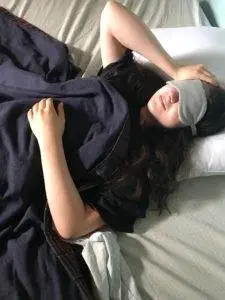By Xiaomei Cai L.Ac., Ph.D. & Qineng Tan, L.Ac., Ph.D.

Migraine is a disorder that affects about 10% of people worldwide; women are three times more likely to suffer migraine headaches than men. A migraine is an intense headache that lasts anywhere from several hours to three days and is severe enough to impede normal activities. The throbbing, pulsating, or stabbing pain in the head typical of a migraine is usually accompanied by a variety of other symptoms, including nausea and increased sensitivity to sensory stimuli. Migraines develop in stages over several hours or days, and the exact nature of the experience differs widely from person to person.
Migraine is a recurrent condition, and patients are typically diagnosed with migraine if they have experienced at least five of these types of headaches in their lifetime. Some people suffer from chronic migraines that cause them to be debilitated several times per month.
There are different types of headaches, but migraine headaches are distinct from tension headaches, sinusitis headaches, and cluster headaches in key ways. Sinus headaches, for example, are related to a sinus infection.
Although much research has been done, the physiological processes that cause migraines are still not completely understood. There is no cure for migraines, and treatment methods focus on preventing migraines from beginning or fully developing, and alleviating the symptoms until the attack abates.
While more research is needed to demonstrate exactly how acupuncture impacts brain chemistry, studies have made it clear that TCM methods and acupuncture treatment are an effective alternative for relieving migraine.
What Causes Migraine?
Current medical theory generally attributes migraines to abnormal neurological functions in the brain cells. This may be due to genetics, as susceptibility to migraines does tend to run in families, especially from mothers to daughters. A cascade of chemical activity, possibly caused by fluctuations in hormones, causes the blood vessels to constrict, which leads to the pressure in head, throbbing pain and elevated nerve sensations. Migraines have also been linked to carpal tunnel syndrome, a nerve condition in which the median nerve is compressed. TMJ, or disorders of the jaw, can also contribute to migraines. Meniere’s disease, an inner ear problem that causes vertigo, dizziness, ringing in the ears, and nausea, has also been linked to migraines. Occipital neuralgia, which occurs when the occipital nerves are compressed or irritated, can cause migraine-like pain in the back of head and neck.
Stages and Symptoms of Migraine
Migraines do not simply cause a severe headache. Migraine episodes go through a pattern of stages, during which a variety of symptoms come and go. While a person may not be able to predict when a migraine will come on, once he or she is familiar with these stages, the course of the migraine attack is somewhat predictable.
- Premonitory or Prodrome Stage of Migraine – In the early part of the migraine, a person might experience physical signs such as stiffness in the neck (cervicogenic headache), especially on one side, frequent yawning, cravings for certain foods, marked thirstiness, and increased urination. Emotionally and mentally, a sense of fatigue, irritability, depression, or confusion might pervade. Some people feel hyperactive or even euphoric. This period can last for hours or days.
- Aura – Not everyone who has migraines experiences what is known as the Aura phase, which produces unusual sensory distortions. In other cases, people may experience the Aura phase, but not the subsequent headache pain phase. Some examples of migraine with aura symptomology include: Allodynia (hypersensitivity to touch, so much that it is painful), Metamorphopsia – a profound change in perception of the size of objects, including one’s own body, altered spatial awareness, Aphasia – impairment in the language center of the brain that causes forgetting words, feeling generally unable to express oneself verbally, Visual – seeing wavy lines or flashing lights (phosphenes), “blind spots” or reduced field of vision (scotoma), Auditory – loss of hearing, auditory hallucinations, Headache and dizziness or vertigo.
- Headache – Some people may have only mild pain during this phase, and therefore do not recognize they are having a migraine. Many migraine sufferers, however, experience severe throbbing headache, sharp pain in head, or stabbing pain (ice pick headache), often on one side of the head, headache back of head, headache behind eyes, or in the temples on head. The pain is usually worse if one is active. Heightened sensitivity to light, sounds, and smells are common, and people usually feel like retreating to a dark, quiet room to lie down. During this phase, people may also experience nausea and/or vomiting, dehydration, dizziness, hot flashes and/or chills, and strong emotions such as anxiety, fear, and depression. This phase can last anywhere from several hours to three days.
- Postdrome – The final phase of migraine is sometimes likened to a “hangover.” People generally feel low energy and low mood, as well as fatigue and compromised cognitive function. This phase, too, can last several hours to a few days.
Migraine episodes have a devastating impact on people’s ability to function normally. More than half of migraine sufferers miss at least two days of work per month, and many more try to get through their workdays even though they are in the middle of a migraine.
Are Migraines Related to Hormones?

While anyone can have migraines, women are three times more likely to experience them, especially during their reproductive years. Many women perceive their migraine to be a PMS headache or period headache, because it occurs prior to or during the menstrual period. These types of migraine can be particularly debilitating. The cause of headache is believed to be due to a sudden drop in estrogen. This same mechanism can cause frequent headaches during perimenopause or early menopause due to fluctuations in estrogen levels.
Sometimes women are prescribed the use of continual oral contraceptive medication (i.e., skipping the placebo week of pills) in order to prevent drops in estrogen that may be causing migraine. This treatment does not work for everyone, though, and obviously is not helpful for women who may wish to get pregnant.
Serotonin levels have also been linked to migraine. Research has shown that fluctuations in neurotransmitters and vascular functions in the brain are part of the migraine pathology, but it remains unclear exactly how this plays out. Triptans, drugs which act upon the serotonin receptors in the brain, are currently the most common treatment for acute migraine, as in some cases, they will stop a migraine attack from progressing. These medications do not work for everyone, though, and they cause constriction of blood vessels, which can lead to other problems, such as tightness, tingling, and hot flushes in various parts of the body.
Targeting the production and function of one of two specific hormones may produce some positive results, but as migraines appear to stem from a complex combination of hormonal, vascular, and metabolic malfunctions, a more holistic approach may be indicated. Acupuncture has been shown to help regulate hormones like estrogen and serotonin, specifically, but TCM achieves those results by observing and treating the whole person, emotionally, mentally, and physically; not only focusing on one or two isolated chemicals.
Acupuncture and TCM for Migraine Help
TCM theory is based on the concept of Qi as a life force energy which flows through the body along channels called meridians. Qi and blood move through these channels, several of which meet in the head. Blockages and stagnation in one organ system can impact other organ systems. Recurrent migraines are considered to be caused by stasis and deficiencies in the liver, spleen, and kidney, which cause yang energy from the liver to rise to the head. Overconsumption of the wrong kinds of foods can cause phlegm build-up in these organs, while alcohol and pungent foods can create excess heat energy. A typical TCM treatment protocol might involve using specific acupuncture points and herbs to quench liver fire and eliminate phlegm.
Acupuncture can work on migraine pain with its natural analgesic effects, while also helping to prevent future attacks by resolving these deeper organ system imbalances. One study showed that migraine patients given acupuncture treatment experienced fewer episodes and missed fewer days of work than those given medications. The results also indicated that acupuncture was more cost effective than the medications. A review of randomized trials involving thousands of patients concluded that acupuncture is effective at reducing the number of days lost to migraines and should be considered a valuable treatment option.
Top 5 Home Remedies for Migraine Headaches

Migraines appear to be triggered by various stressors, lack of sleep, and certain foods. Aside from seeking acupuncture near me for migraine, there are several things you can do to prevent and relieve severe headaches. Natural remedies for migraines involve simple dietary, exercise and lifestyle modifications.
- Avoid foods that can trigger migraines. The most common ones are processed or prepared foods with added nitrates or MSG. Dairy products, especially very salty or aged cheeses, and chocolate should be avoided if you are susceptible to migraine, as well as extremely cold drinks and desserts. Dried foods like fruits and beans, and pickled foods can also be problematic.
- Emphasize foods high in magnesium, especially nuts, seeds, and high quality eggs.
- Ginger is known to relieve nausea and vomiting, and may alleviate other effects of migraine. One study showed that ginger was just as effective as Sumatriptan for decreasing symptoms of migraine. We recommend simply slicing fresh ginger root and steeping it in hot water to drink as a tea.
- Try essential oils like lavender or peppermint. Rubbing a little bit into the temples can be soothing.
- Find a gentle practice that combines breathing, movement, and meditation. Yoga, particularly restorative yoga, has been shown to be helpful for headaches. This may be because it helps people relax more fully. It also encourages better symmetry between the right and left sides of the body and brain.
Best Acupuncture in Los Angeles for Migraine Help
Drs. Cai and Tan at Art of Wellness in Santa Monica have over thirty years of experience treating migraine and other types of headache with TCM, acupuncture, and herbal remedies. Headache help is just a phone call away. If you or someone you know has been suffering with severe headache or chronic migraines, please do not wait another day to call 310-451-5522 and get started with an acupuncture treatment program that will allow you to reclaim your life and experience headache relief.
*This article is for education from the perspective of Traditional Chinese Medicine only. The education provided by this article is not approved by FDA to diagnose, prevent, treat and cure human diseases. It should not stop you from consulting with your physician for your medical conditions. Traditional Chinese Medicine is based on Qi, which is an invisible force that usually cannot be observed by modern science. Because science focuses on testing ideas about the natural world with evidence obtained through observation, these aspects of acupuncture can’t be studied by science. Therefore acupuncture and Chinese herbs are often not supported by double-blind, randomized trials, and they are considered alternative medicine therapies in the United States.
